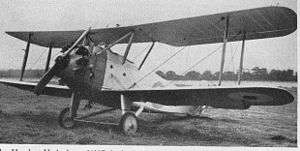Hawker Hedgehog
| Hedgehog | |
|---|---|
 | |
| Role | Naval reconnaissance |
| Manufacturer | Hawker Aircraft |
| First flight | 1924 |
| Status | Prototype |
| Number built | 1 |
|
| |
The Hawker Hedgehog was a three-seat reconnaissance biplane, to be used for naval scouting, produced to meet Air Ministry Specification 37/22.
It was designed in 1923, and had its first flight the next year, piloted by FP Raynham. The crew consisted of the pilot, an observer and an air gunner. Construction was typical of the period: a wooden structure covered with fabric. The powerplant was a nine-cylinder Bristol Jupiter IV radial engine driving a two-bladed wooden propeller.
While testing was successful, on completion of the flight tests, the project was cancelled. This was due to the Hedgehog's performance not being sufficiently better than the existing aircraft used for Naval reconnaissance, the Avro Bison and Blackburn Blackburn. Consequently, only one prototype was built. The armament of the aircraft was one fixed forward-firing .303 in (7.7 mm) Vickers gun and one .303 in (7.7 mm) Lewis gun on a Scarff ring in the rear cockpit. The aircraft was fitted with floats that contained wheels to enable use as an amphibian. The wings could be folded, so that the width was reduced to 16 ft 7½ in (4.87 m) for storage.
Specifications
Data from Hawker Aircraft since 1920 [1]
General characteristics
- Crew: three
- Length: 30 ft 8¾ in (9.36 m)
- Wingspan: 40 ft ¼ in (12.20 m)
- Height: 12 ft 6 in (3.81 m)
- Wing area: 480.7 ft² (44.66 m²)
- Empty weight: 2,995 lb (1,358 kg)
- Loaded weight: 4,791 lb (2,173 kg)
- Max. takeoff weight: 4,800 lb [2] (2,182 kg)
- Powerplant: 1 × Bristol Jupiter IV 9-cylinder radial engine driving a two-bladed wooden propeller, 398 hp (300 kW)
Performance
- Maximum speed: 120.5 mph (105 kn, 194 km/h) at sea level
- Cruise speed: 89 mph (77 kn, 143 km/h)
- Stall speed: 45 mph (39 kn, 72 km/h)
- Service ceiling: 13,500 ft (4,115 m)
- Climb:23 minutes 59 seconds to 10,000 ft (3,044 m)
- Endurance: 2.5 hours
Armament
- Guns:
- 1 × 0.303 in (7.7 mm) Vickers machine gun
- 1 × 0.303 in Lewis gun on a Scarff ring
References
| Wikimedia Commons has media related to Hawker Hedgehog. |
- Mason, Francis K. Hawker Aircraft since 1920 London:Putnam, 1991. ISBN 0-85177-839-9.